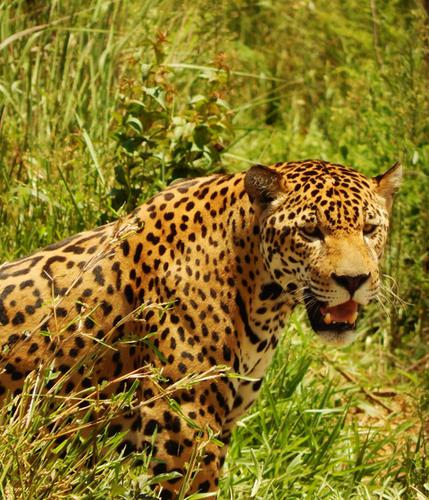当前位置:
X-MOL 学术
›
Anim. Conserv.
›
论文详情
Our official English website, www.x-mol.net, welcomes your feedback! (Note: you will need to create a separate account there.)
Reserve size, dispersal and population viability in wide ranging carnivores: the case of jaguars in Emas National Park, Brazil
Animal Conservation ( IF 3.4 ) Pub Date : 2020-06-05 , DOI: 10.1111/acv.12608 S. P. Finnegan 1, 2, 3 , L. Galvez‐Bravo 2 , L. Silveira 3 , N. M. Tôrres 3, 4 , A. T. A Jácomo 3 , G. B. Alves 3, 4 , F. Dalerum 5, 6, 7
Animal Conservation ( IF 3.4 ) Pub Date : 2020-06-05 , DOI: 10.1111/acv.12608 S. P. Finnegan 1, 2, 3 , L. Galvez‐Bravo 2 , L. Silveira 3 , N. M. Tôrres 3, 4 , A. T. A Jácomo 3 , G. B. Alves 3, 4 , F. Dalerum 5, 6, 7
Affiliation

|
Protected areas may be important refuges for large carnivores, but many are not large enough to sustain viable populations. Without sufficient dispersal between protected areas, large carnivore populations inside them are at risk of becoming genetically isolated and demographically vulnerable. In this study, we use the jaguar population in and around Emas National Park in the Brazilian Cerrado as a case study to evaluate the demographic sustainability of a large carnivore population within a small and potentially isolated protected area. We used camera trapping data and spatially explicit capture‐recapture models to estimate density and corresponding population size of jaguars in Emas National Park. We then used a matrix‐based age and sex structured stochastic population model to evaluate the demographic viability of jaguar populations across a range of population sizes, including those estimated for Emas. We detected 10 individual jaguars during our survey with a total of 74 detections. Our density estimation became unbiased using a buffer width of 30 km and produced a density of 0.17 jaguars per 100 km2. The estimated population sizes of 10–60 animals suffered extinction risks of 70–90% without net immigration. However, only a low number of immigrants were required to suppress extinction risk towards zero. Our density estimate for jaguars was lower than in previous studies, and our simulations suggested that this population may have a substantial extinction risk. Ensuring dispersal and connectivity outside of protected areas, through the implementation of habitat corridors, can greatly reduce this extinction risk, and we suggest that this scenario is potentially applicable to many other large carnivore populations.
中文翻译:

各种食肉动物的储藏量,传播和种群生存力:以巴西埃马斯国家公园的美洲虎为例
保护区可能是大型食肉动物的重要避难所,但许多保护区的规模不足以维持生存人口。如果在保护区之间没有足够的分散,保护区内的大量食肉动物就有被遗传隔离和人口脆弱的风险。在这项研究中,我们以巴西塞拉多(Cerrado)埃马斯国家公园(Emas National Park)及其周围的美洲虎种群为例,评估了在较小且可能隔离的保护区内的大型食肉动物种群的人口可持续性。我们使用相机捕获数据和空间上明确的捕获-再捕获模型来估计埃马斯国家公园中美洲虎的密度和相应种群的大小。然后,我们使用基于矩阵的年龄和性别结构的随机种群模型来评估美洲虎种群在各种种群规模(包括为Emas估算的种群规模)中的人口生存力。在我们的调查中,我们共检出10头美洲虎,共发现74头。使用30 km的缓冲区宽度,我们的密度估计变得无偏,并且每100 km产生0.17美洲虎密度2。在没有净移民的情况下,估计的10-60只动物的种群灭绝风险为70-90%。但是,只需要少数移民就能将灭绝风险抑制为零。我们对美洲虎的密度估计比以前的研究要低,并且我们的模拟表明该美洲虎的灭绝风险可能很大。通过实施栖息地走廊,确保在保护区之外的扩散和连通性可以大大降低灭绝的风险,我们建议这种情况可能适用于许多其他大型食肉动物种群。
更新日期:2020-06-05
中文翻译:

各种食肉动物的储藏量,传播和种群生存力:以巴西埃马斯国家公园的美洲虎为例
保护区可能是大型食肉动物的重要避难所,但许多保护区的规模不足以维持生存人口。如果在保护区之间没有足够的分散,保护区内的大量食肉动物就有被遗传隔离和人口脆弱的风险。在这项研究中,我们以巴西塞拉多(Cerrado)埃马斯国家公园(Emas National Park)及其周围的美洲虎种群为例,评估了在较小且可能隔离的保护区内的大型食肉动物种群的人口可持续性。我们使用相机捕获数据和空间上明确的捕获-再捕获模型来估计埃马斯国家公园中美洲虎的密度和相应种群的大小。然后,我们使用基于矩阵的年龄和性别结构的随机种群模型来评估美洲虎种群在各种种群规模(包括为Emas估算的种群规模)中的人口生存力。在我们的调查中,我们共检出10头美洲虎,共发现74头。使用30 km的缓冲区宽度,我们的密度估计变得无偏,并且每100 km产生0.17美洲虎密度2。在没有净移民的情况下,估计的10-60只动物的种群灭绝风险为70-90%。但是,只需要少数移民就能将灭绝风险抑制为零。我们对美洲虎的密度估计比以前的研究要低,并且我们的模拟表明该美洲虎的灭绝风险可能很大。通过实施栖息地走廊,确保在保护区之外的扩散和连通性可以大大降低灭绝的风险,我们建议这种情况可能适用于许多其他大型食肉动物种群。


























 京公网安备 11010802027423号
京公网安备 11010802027423号